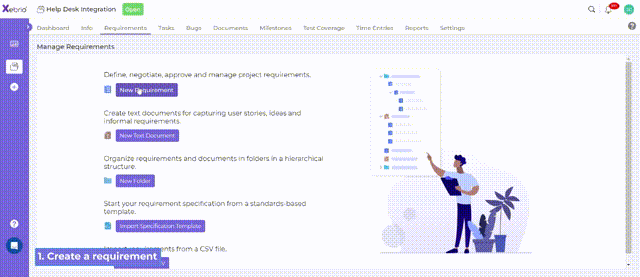For project where there are multiple stakeholders involving people who are internal or external to the team, it becomes imperative that the requirement approval process must be streamlined to make it transparent, and process driven. Gathering requirements over informal channels like email or spreadsheet is a recipe for project failures. It is therefore important to have a certain workflow to approve requirements involving stakeholders and making the activity transparent and process driven.
What is an Approval Workflow in Requirements Management?
An approval workflow in requirements management is a defined process for reviewing, evaluating, and approving requirements before they are implemented. The goal of the approval workflow is to ensure that requirements are well-defined, relevant, and aligned with project goals and objectives. The approval workflow typically includes the following steps:
- Submitting the requirement for review.
- Reviewing the requirement by a designated group of stakeholders or subject matter experts.
- Evaluating the requirement against project goals and objectives.
- Providing feedback on the requirement.
- Revising the requirement based on feedback.
- Approving or rejecting the requirement.
- Documenting the approval or rejection decision and reason.
Why is a Requirements Approval Workflow Important??
A requirements approval workflow is important to ensure the project teams and the stakeholders work in tandem with one another. It reduces the risks in a project, as well as any scope creep and later rework in the project. It also provides a written record of the requirements and approvals, which can prove valuable for later auditing.
What Are the Best Practices to Involve Stakeholders While Gathering Project Requirements?
- The best practices to involve stakeholders while gathering project requirements are:
- Clearly define the requirements.
- Schedule regular meetings to gather feedback.
- Encourage active participation and feedback from them.
- Document, prioritize, and manage requirements.
- Validate requirements and adjust according to stakeholder feedback.
- Foster open communication and maintain transparency throughout the project.
What Makes Xebrio’s Requirements Approval Process Vital for Project Teams?
A project usually has multiple stakeholders, from internal stakeholders (project team) to external stakeholders (clients, vendors, etc.) to an organization.
These stakeholders are often involved in various project or product development phases, starting with the requirements-gathering phase.
It is imperative for these stakeholders to be involved and be actively engaged in gathering requirements with utmost transparency.
Xebrio’s project requirements approval workflow is designed for such use cases.
With Xebrio’s approval workflow, you can:
- Involve project stakeholders
- Streamline approvals
- Get requirements reviewed on time
- Manage requirement changes with ease
Xebrio’s workflow approval lets you add contributors and reviewers to get your requirements and documents approved. It provides complete transparency from requirements gathering to finalization.
Xebrio has also provided the ‘self-approval’ option if there are no other stakeholders involved in the project. Users can self-approve requirements empowering them with the complete autonomy in the project.
Here Are the Steps to Create an Approval Workflow with Xebrio:

1. Create a requirement
Create a new requirement. You may create a new requirement or use a pre-existing template.
2. Add reviewers and contributors.
Reviewers: External stakeholders who approve or reject your requirement. They may also suggest changes to the requirement.
Contributors: Co-authors who you collaborate with while drafting the requirements.
3. Get the requirement reviewed.
Once you draft the requirement, send it ahead for review. The reviewers may approve the requirement if there are no changes or reject and suggest changes.
4. Finalize the requirement
After you make the desired changes to the requirement and are approved, finalize the requirement draft.
In Conclusion
In conclusion, the process of the approval workflow promotes active involvement and engagement of stakeholders, improving the quality of requirements, reducing rework, and increasing transparency and accountability in the project. Implementing a requirements approval workflow can greatly contribute to the success of a project by ensuring that requirements are well-understood and properly aligned with project goals and objectives.






0 Comments